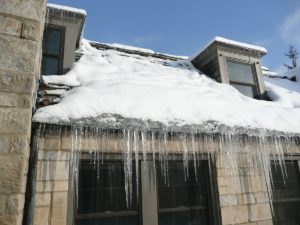Questions About Ice Dams on Your Roofs and Gutters in Kansas City?
Ice dams can affect any type of roof, and if you don’t take the proper precautions, you could be the next victim of a 100% preventable problem!
Ice dams form on the parts of your roof that do not get warm enough to melt snow and ice, or at least, they don’t stay warm for very long, creating the perfect circumstances for ice dams to form. When ice and snow build up, it puts a lot of extra weight on your roof. This can lead to structural damage, not to mention the leaks that are inevitably caused when ice dams build up for some time.
The good thing is that most insurance policies do cover the damages caused by ice dams. However, if you can avoid the complete inconvenience of having your roof worked on, wouldn’t you rather? Above All Construction has some tips, information, and much needed advice that will keep ice dams from damaging your roof!
The effects of ice dams on your roof and gutters may not be apparent right away. Sometimes it is well after temperatures begin to rise that homeowners realize there is a big problem. Ultimately, ice dams can cause leaks in your roof due to the freeze-thaw cycle.
Here are a few signs that will let you know right away that you could have an ice dam on your roof:
- After a fresh snow, look for “hot spots” on your roof where the snow has melted too quickly. Air leaks around your chimney or other roof outlets are common areas for hot spots to form. When the snow melts quickly, it can refreeze further down the roof, usually in or near the gutter.
- If precipitation is melting and refreezing while dripping off the gutters or roof edges, there could definitely be a problem.
- If you see snow building up in low places on your roof, this is a potential circumstance for ice dams to form. Sometimes, the sheer amount of snow that accumulates can be the ultimate culprit.
- Inside your home, you could see wetness on the rafters overhead in the attic, or you may even see water stains on the ceiling if the leak is large or has been there for a while.
- Shingles or other roofing material may be lifted due to constant freezing and thawing. If you see raised shingles, it could mean that you have an ice dam currently or have had one in the past.
You can do several things yearly to prevent ice dams from forming in the first place. Keep your gutters cleaned out, first of all. You can also purchase a roof rake that can be used safely from the ground. If you’re serious about never seeing an ice dam again, you can always install heated gutter cables that plug into your home’s electrical system! These systems are simple to install, but you’ll still need a pro roofer or electrician to help you get it just right.

